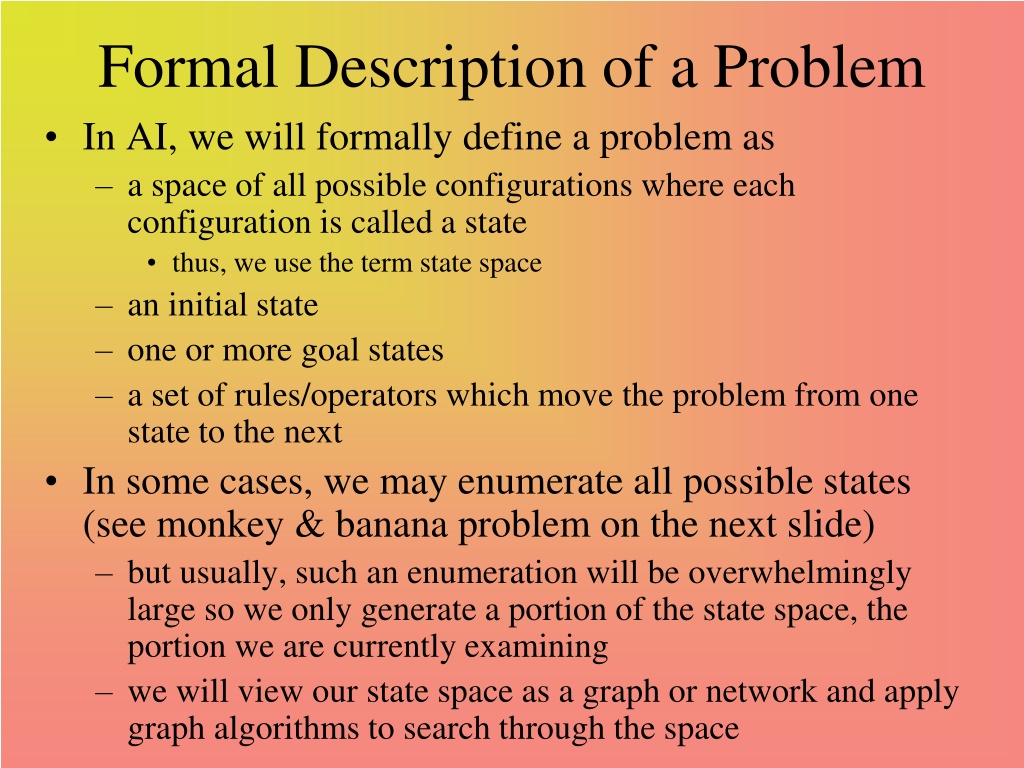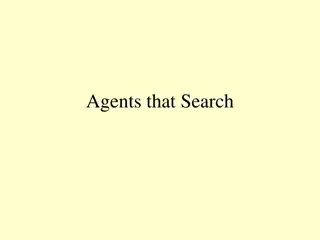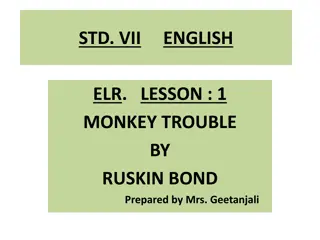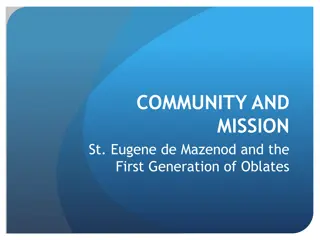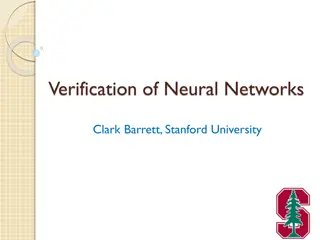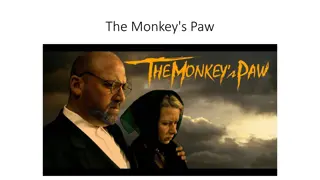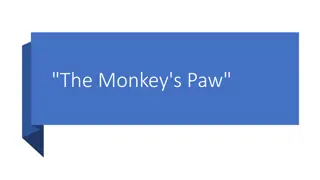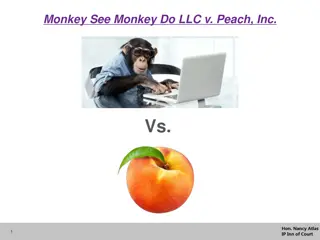Formal Problem Definitions in AI: Monkey & Bananas, Missionaries & Cannibals
Formally defining problem-solving in AI involves representing possible configurations as states in a state space, with initial and goal states, and a set of actions to transition between states. Examples like the Monkey & Bananas and Missionaries & Cannibals problems illustrate this concept by outlining initial states, goal states, and permissible actions.
Uploaded on Sep 22, 2024 | 0 Views
Download Presentation

Please find below an Image/Link to download the presentation.
The content on the website is provided AS IS for your information and personal use only. It may not be sold, licensed, or shared on other websites without obtaining consent from the author. Download presentation by click this link. If you encounter any issues during the download, it is possible that the publisher has removed the file from their server.
E N D
Presentation Transcript
Formal Description of a Problem In AI, we will formally define a problem as a space of all possible configurations where each configuration is called a state thus, we use the term state space an initial state one or more goal states a set of rules/operators which move the problem from one state to the next In some cases, we may enumerate all possible states (see monkey & banana problem on the next slide) but usually, such an enumeration will be overwhelmingly large so we only generate a portion of the state space, the portion we are currently examining we will view our state space as a graph or network and apply graph algorithms to search through the space
The Monkey & Bananas Problem A monkey is in a cage and bananas are suspended from the ceiling, the monkey wants to eat a banana but cannot reach them in the room are a chair and a stick if the monkey stands on the chair and waves the stick, he can knock a banana down to eat it what are the actions the monkey should take? Initial state: monkey on ground with empty hand bananas suspended Goal state: monkey eating Actions: climb chair/get off grab X wave X eat X
Missionaries and Cannibals 3 missionaries and 3 cannibals are on one side of the river with a boat that can take exactly 2 people across the river how can we move the 3 missionaries and 3 cannibals across the river with the constraint that the cannibals never outnumber the missionaries on either side of the river (lest the cannibals start eating the missionaries!)?? We can represent a state as a 6-item tuple: (a, b, c, d, e, f) a/b = number of missionaries/cannibals on left shore c/d = number of missionaries/cannibals in boat e/f = number of missionaries/cannibals on right shore where a + b + c + d + e + f = 6 and c + d <= 2, c + d >= 1 to move the boat a >= b unless a = 0, c >= d unless c = 0, e >= f unless e = 0 Legal operations (moves) are 0, 1, 2 missionaries get into boat (c + d must be <= 2) 0, 1, 2 missionaries get out of boat 0, 1, 2 cannibals get into boat (c + d must be <= 2) 0, 1, 2 missionaries get out of boat boat sails from left shore to right shore (c + d must be >= 1) boat sails from right shore to left shore (c + d must be >= 1) drawing the state space will be left as a homework problem
8 Puzzle The 8 puzzle search space consists of 8! states (40320)
Graph/Network Theory A graph is denoted as G = {V, E} V = set of vertices (nodes) E = set of edges an edge is denoted as (a, b) to indicate an edge exists between node a and node b a network is a graph in which edges have weights (the cost of traversing from one node to another) A graph is directed if an edge can only be traversed in one direction in a directed graph, (a, b) does not mean there exists (b, a) but in an undirected graph, (a, b) = (b, a) A path is a set of 1 or more edges that lead you from one node to another A graph contains a cycle if there is a path whose length > 1 such that you can go from a node back to itself A tree is a special case of a graph which contains no cycles and nodes are given relationships of parents and children the root of a tree is the topmost node (has no parents) and leafs are nodes that have no children
Search Given a problem expressed as a state space (whether explicitly or implicitly) with operators/actions, an initial state and a goal state, how do we find the sequence of operators needed to solve the problem? this requires search Formally, we define a search space as [N, A, S, GD] N = set of nodes or states of a graph A = set of arcs (edges) between nodes that correspond to the steps in the problem (the legal actions or operators) S = a nonempty subset of N that represents start states GD = a nonempty subset of N that represents goal states Our problem becomes one of traversing the graph from a node in S to a node in GD we can use any of the numerous graph traversal techniques for this but in general, they divide into two categories: brute force unguided search heuristic guided search
Consequences of Search As shown a few slides back, the 8-puzzle has over 40000 different states what about the 15 puzzle? A brute force search means try all possible states blindly until you find the solution (blindly means without knowledge guiding you) if a problem has a state space that consists of n moves where each move has m possible choices, then there are 2m*n states two forms of brute force search are: depth first search, breath first search A guided search uses some heuristic (a function) to determine how good a particular state is to help determine which state to move on to - goodness is a judgment of how likely this node is to lead you to a goal state hill climbing best-first search A/A* algorithm Minimax While a good heuristic can reduce the complexity from 2m*n to something tractable, there is no guarantee so any form of search is O(2n) in the worst case
Forward vs Backward Search The common form of reasoning starts with data and leads to conclusions for instance, diagnosis is data-driven given the patient symptoms, we work toward disease hypotheses we often think of this form of reasoning as forward chaining through rules Backward search reasons from goals to actions Planning and design are often goal-driven backward chaining
Depth-first Search Starting at node A, our search gives us: A, B, E, K, S, L, T, F, M, C, G, N, H, O, P, U, D, I, Q, J, R
Breadth-First Search Starting at node A, our search would generate the nodes in alphabetical order from A to U
8 Queens Can you place 8 queens on a chess board such that no queen can capture another? uses a recursive algorithm with backtracking the more general problem is the N-queens problem (N queens on an NxN chess board) solve(board, col, row) if col = n then return true; // success else row = 0; placed = false; while(row < n && !placed) board[row][col] = true // place the queen if(cannotCapture(board, col)) placed = true else board[row][col] = false; row++ if(row = n) col--; placed = false; row = 0; // backtrack
And/Or Graphs To this point in our consideration of search spaces, a single state (or the path to that state) represents a solution in some problems, a solution is a combination of states or a combination of paths we pursue a single path, until we reach a dead end in which case we backtrack, or we find the solution (or we run out of possibilities if no solution exists) so our state space is an Or graph every different branch is a different solution, only one of which is required to solve the problem However, some problems can be decomposed into subproblems where each subproblem must be solved consider for instance integrating some complex function which can be handled by integration by parts such as state space would comprise an And/Or graph where a path may lead to a solution, but another path may have multiple subpaths, all of which must lead to solutions
And/Or Graphs as Search Spaces Integration by parts, as used in the MACSYMA expert system if we use the middle branch, we must solve all 3 parts (in the final row) Our Financial Advisor system from chapter 2 each possible investment solution requires proving 3 things
Data-driven Example: Parsing We wrap up this chapter by considering an example of syntactically parsing an English sentence we have the following five rules: sentence np vp np n np art n vp v vp v np n is noun man or dog v is verb likes or bites Art is article a or the Parse the following sentence: The dog bites the man.
